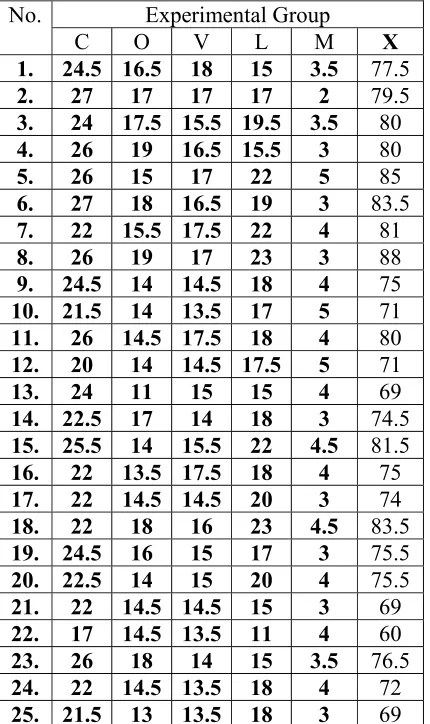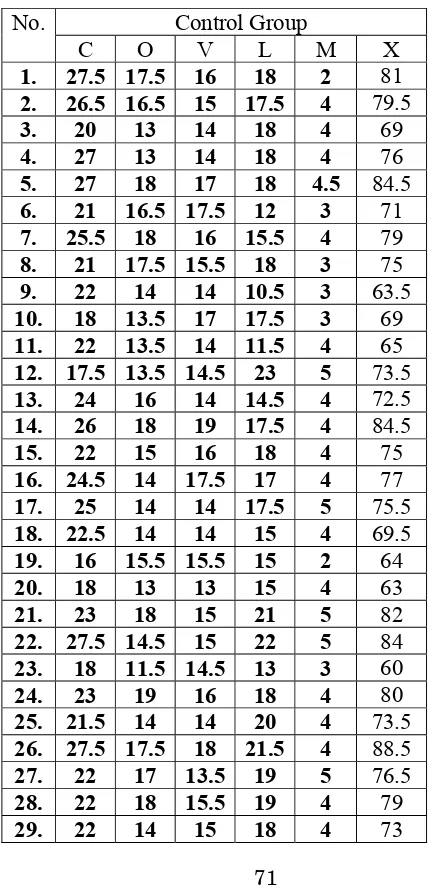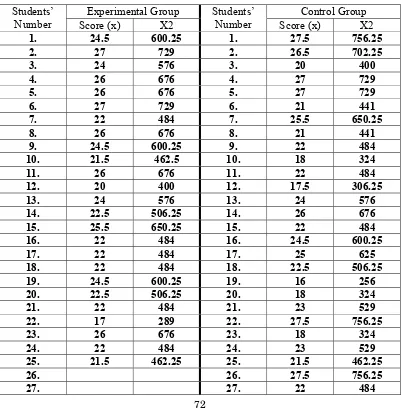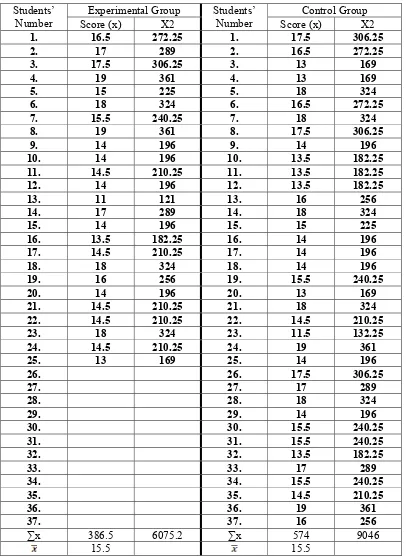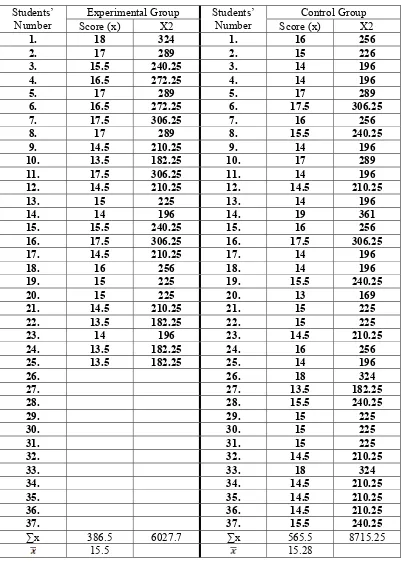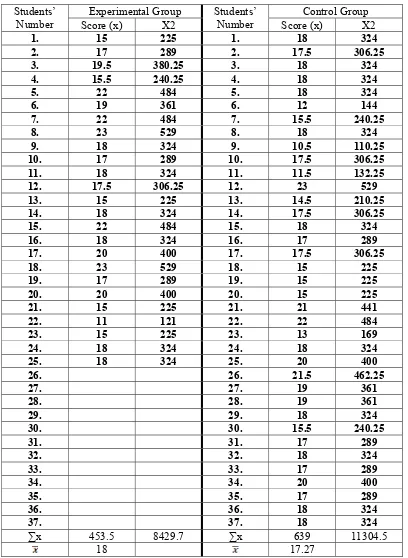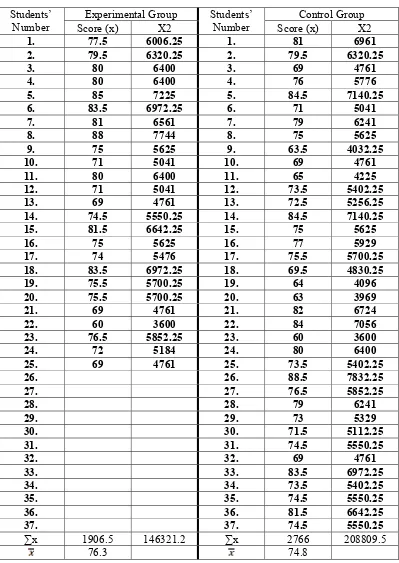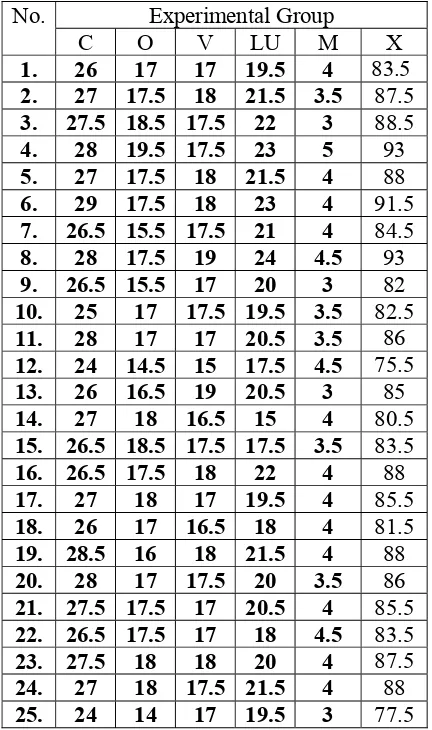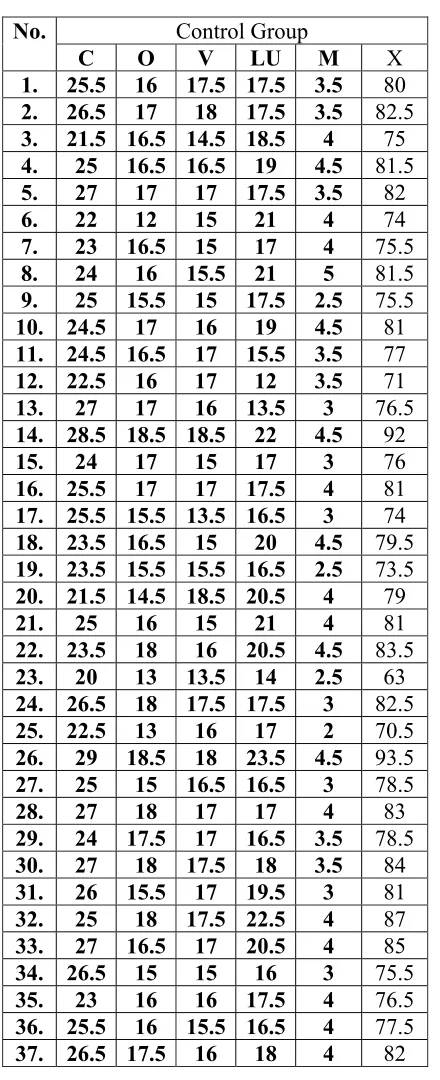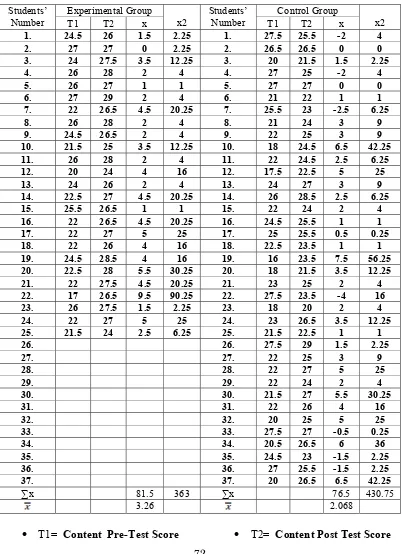80
APPENDIX 1
Table 1
THE RESULT OF THE EXPERIMENTAL GROUP PRE-TEST
Experimental Group No.
C O V L M X
1. 24.5 16.5 18 15 3.5 77.5
2. 27 17 17 17 2 79.5
3. 24 17.5 15.5 19.5 3.5 80
4. 26 19 16.5 15.5 3 80
5. 26 15 17 22 5 85
6. 27 18 16.5 19 3 83.5
7. 22 15.5 17.5 22 4 81
8. 26 19 17 23 3 88
9. 24.5 14 14.5 18 4 75
10. 21.5 14 13.5 17 5 71
11. 26 14.5 17.5 18 4 80
12. 20 14 14.5 17.5 5 71
13. 24 11 15 15 4 69
14. 22.5 17 14 18 3 74.5
15. 25.5 14 15.5 22 4.5 81.5
16. 22 13.5 17.5 18 4 75
17. 22 14.5 14.5 20 3 74
18. 22 18 16 23 4.5 83.5
19. 24.5 16 15 17 3 75.5
20. 22.5 14 15 20 4 75.5
21. 22 14.5 14.5 15 3 69
22. 17 14.5 13.5 11 4 60
23. 26 18 14 15 3.5 76.5
24. 22 14.5 13.5 18 4 72
71
C = Content Score
O = Organization Score
V = Vocabulary Score
LU = Language Use Score
M= Mechanics Score
X= Pre-test Score
Table 2
THE RESULT OF THE CONTROL GROUP PRE-TEST
Control Group No.
C O V L M X
1. 27.5 17.5 16 18 2 81
2. 26.5 16.5 15 17.5 4 79.5
3. 20 13 14 18 4 69
4. 27 13 14 18 4 76
5. 27 18 17 18 4.5 84.5
6. 21 16.5 17.5 12 3 71
7. 25.5 18 16 15.5 4 79
8. 21 17.5 15.5 18 3 75
9. 22 14 14 10.5 3 63.5
10. 18 13.5 17 17.5 3 69
11. 22 13.5 14 11.5 4 65
12. 17.5 13.5 14.5 23 5 73.5
13. 24 16 14 14.5 4 72.5
14. 26 18 19 17.5 4 84.5
15. 22 15 16 18 4 75
16. 24.5 14 17.5 17 4 77
17. 25 14 14 17.5 5 75.5
18. 22.5 14 14 15 4 69.5
19. 16 15.5 15.5 15 2 64
20. 18 13 13 15 4 63
21. 23 18 15 21 5 82
22. 27.5 14.5 15 22 5 84
23. 18 11.5 14.5 13 3 60
24. 23 19 16 18 4 80
25. 21.5 14 14 20 4 73.5
26. 27.5 17.5 18 21.5 4 88.5
27. 22 17 13.5 19 5 76.5
28. 22 18 15.5 19 4 79
72
30. 21.5 15.5 15 15.5 4 71.5
31. 22 15.5 15 17 5 74.5
32. 20 13.5 14.5 18 3 69
33. 27.5 17 18 17 4 83.5
34. 20.5 15.5 14.5 20 3.5 73.5
35. 24.5 14.5 14.5 17 4 74.5
36. 27 19 14.5 18 3 81.5
37. 20 16 15.5 18 5 74.5
C = Content Score
O = Organization Score
V = Vocabulary Score
LU = Language Use Score
M = Mechanics Score
X= Pre-test Score
APPENDIX 2
Table 1
THE CALCULATION OF THE PRE-TEST OF CONTENT SCORE
Experimental Group Control Group Students’
Number Score (x) X2
Students’
Number Score (x) X2
1. 24.5 600.25 1. 27.5 756.25
2. 27 729 2. 26.5 702.25
3. 24 576 3. 20 400 4. 26 676 4. 27 729 5. 26 676 5. 27 729 6. 27 729 6. 21 441
7. 22 484 7. 25.5 650.25
8. 26 676 8. 21 441
9. 24.5 600.25 9. 22 484
10. 21.5 462.5 10. 18 324
11. 26 676 11. 22 484
12. 20 400 12. 17.5 306.25
13. 24 576 13. 24 576
14. 22.5 506.25 14. 26 676
15. 25.5 650.25 15. 22 484
16. 22 484 16. 24.5 600.25
17. 22 484 17. 25 625
18. 22 484 18. 22.5 506.25
19. 24.5 600.25 19. 16 256
20. 22.5 506.25 20. 18 324
21. 22 484 21. 23 529
22. 17 289 22. 27.5 756.25
23. 26 676 23. 18 324 24. 22 484 24. 23 529
25. 21.5 462.25 25. 21.5 462.25
26. 26. 27.5 756.25
74
28. 28. 22 484
29. 29. 22 484
30. 30. 21.5 462.25
31. 31. 22 484
32. 32. 20 400
33. 33. 27.5 756.25
34. 34. 20.5 420.25
35. 35. 24.5 600.25
36. 36. 27 729
37. 37. 20 400
∑x 588 13971 ∑x 842.5 19555.2
75
Table 2
THE CALCULATION OF THE PRE-TEST OF ORGANIZATION
SCORE
Experimental Group Control Group Students’
Number Score (x) X2
Students’
Number Score (x) X2
1. 16.5 272.25 1. 17.5 306.25
2. 17 289 2. 16.5 272.25
3. 17.5 306.25 3. 13 169
4. 19 361 4. 13 169 5. 15 225 5. 18 324
6. 18 324 6. 16.5 272.25
7. 15.5 240.25 7. 18 324
8. 19 361 8. 17.5 306.25
9. 14 196 9. 14 196
10. 14 196 10. 13.5 182.25
11. 14.5 210.25 11. 13.5 182.25
12. 14 196 12. 13.5 182.25
13. 11 121 13. 16 256 14. 17 289 14. 18 324 15. 14 196 15. 15 225
16. 13.5 182.25 16. 14 196
17. 14.5 210.25 17. 14 196
18. 18 324 18. 14 196
19. 16 256 19. 15.5 240.25
20. 14 196 20. 13 169
21. 14.5 210.25 21. 18 324
22. 14.5 210.25 22. 14.5 210.25
23. 18 324 23. 11.5 132.25
24. 14.5 210.25 24. 19 361
25. 13 169 25. 14 196
26. 26. 17.5 306.25
27. 27. 17 289
28. 28. 18 324
29. 29. 14 196
30. 30. 15.5 240.25
31. 31. 15.5 240.25
32. 32. 13.5 182.25
33. 33. 17 289
34. 34. 15.5 240.25
35. 35. 14.5 210.25
36. 36. 19 361
37. 37. 16 256
∑x 386.5 6075.2 ∑x 574 9046
76
Table 3
THE CALCULATION OF THE PRE-TEST OF VOCABULARY
SCORE
Experimental Group Control Group Students’
Number Score (x) X2
Students’
Number Score (x) X2
1. 18 324 1. 16 256 2. 17 289 2. 15 226
3. 15.5 240.25 3. 14 196
4. 16.5 272.25 4. 14 196
5. 17 289 5. 17 289
6. 16.5 272.25 6. 17.5 306.25
7. 17.5 306.25 7. 16 256
8. 17 289 8. 15.5 240.25
9. 14.5 210.25 9. 14 196
10. 13.5 182.25 10. 17 289
11. 17.5 306.25 11. 14 196
12. 14.5 210.25 12. 14.5 210.25
13. 15 225 13. 14 196 14. 14 196 14. 19 361
15. 15.5 240.25 15. 16 256
16. 17.5 306.25 16. 17.5 306.25
17. 14.5 210.25 17. 14 196
18. 16 256 18. 14 196
19. 15 225 19. 15.5 240.25
20. 15 225 20. 13 169
21. 14.5 210.25 21. 15 225
22. 13.5 182.25 22. 15 225
23. 14 196 23. 14.5 210.25
24. 13.5 182.25 24. 16 256
25. 13.5 182.25 25. 14 196
26. 26. 18 324
27. 27. 13.5 182.25
28. 28. 15.5 240.25
29. 29. 15 225
30. 30. 15 225
31. 31. 15 225
32. 32. 14.5 210.25
33. 33. 18 324
34. 34. 14.5 210.25
35. 35. 14.5 210.25
36. 36. 14.5 210.25
37. 37. 15.5 240.25
∑x 386.5 6027.7 ∑x 565.5 8715.25
77
Table 4
THE CALCULATION OF THE PRE-TEST OF LANGUAGE USE
SCORE
Experimental Group Control Group Students’
Number Score (x) X2
Students’
Number Score (x) X2
1. 15 225 1. 18 324
2. 17 289 2. 17.5 306.25
3. 19.5 380.25 3. 18 324
4. 15.5 240.25 4. 18 324
5. 22 484 5. 18 324 6. 19 361 6. 12 144
7. 22 484 7. 15.5 240.25
8. 23 529 8. 18 324
9. 18 324 9. 10.5 110.25
10. 17 289 10. 17.5 306.25
11. 18 324 11. 11.5 132.25
12. 17.5 306.25 12. 23 529
13. 15 225 13. 14.5 210.25
14. 18 324 14. 17.5 306.25
15. 22 484 15. 18 324 16. 18 324 16. 17 289
17. 20 400 17. 17.5 306.25
18. 23 529 18. 15 225 19. 17 289 19. 15 225 20. 20 400 20. 15 225 21. 15 225 21. 21 441 22. 11 121 22. 22 484 23. 15 225 23. 13 169 24. 18 324 24. 18 324 25. 18 324 25. 20 400
26. 26. 21.5 462.25
27. 27. 19 361
28. 28. 19 361
29. 29. 18 324
30. 30. 15.5 240.25
31. 31. 17 289
32. 32. 18 324
33. 33. 17 289
34. 34. 20 400
35. 35. 17 289
36. 36. 18 324
37. 37. 18 324
∑x 453.5 8429.7 ∑x 639 11304.5
79
Table 5
THE CALCULATION OF THE PRE-TEST OF THE WHOLE SCORE
Experimental Group Control Group Students’
Number Score (x) X2
Students’
Number Score (x) X2
1. 77.5 6006.25 1. 81 6961
2. 79.5 6320.25 2. 79.5 6320.25
3. 80 6400 3. 69 4761 4. 80 6400 4. 76 5776
5. 85 7225 5. 84.5 7140.25
6. 83.5 6972.25 6. 71 5041
7. 81 6561 7. 79 6241 8. 88 7744 8. 75 5625
9. 75 5625 9. 63.5 4032.25
10. 71 5041 10. 69 4761 11. 80 6400 11. 65 4225
12. 71 5041 12. 73.5 5402.25
13. 69 4761 13. 72.5 5256.25
14. 74.5 5550.25 14. 84.5 7140.25
15. 81.5 6642.25 15. 75 5625
16. 75 5625 16. 77 5929
17. 74 5476 17. 75.5 5700.25
18. 83.5 6972.25 18. 69.5 4830.25
19. 75.5 5700.25 19. 64 4096
20. 75.5 5700.25 20. 63 3969
21. 69 4761 21. 82 6724 22. 60 3600 22. 84 7056
23. 76.5 5852.25 23. 60 3600
24. 72 5184 24. 80 6400
25. 69 4761 25. 73.5 5402.25
26. 26. 88.5 7832.25
27. 27. 76.5 5852.25
28. 28. 79 6241
29. 29. 73 5329
30. 30. 71.5 5112.25
31. 31. 74.5 5550.25
32. 32. 69 4761
33. 33. 83.5 6972.25
34. 34. 73.5 5402.25
35. 35. 74.5 5550.25
36. 36. 81.5 6642.25
37. 37. 74.5 5550.25
∑x 1906.5 146321.2 ∑x 2766 208809.5
80
APPENDIX 3
Table 1
THE RESULT OF THE EXPERIMENTAL GROUP POST TEST
Experimental Group No.
C O V LU M X
1. 26 17 17 19.5 4 83.5
2. 27 17.5 18 21.5 3.5 87.5
3. 27.5 18.5 17.5 22 3 88.5
4. 28 19.5 17.5 23 5 93
5. 27 17.5 18 21.5 4 88
6. 29 17.5 18 23 4 91.5
7. 26.5 15.5 17.5 21 4 84.5
8. 28 17.5 19 24 4.5 93
9. 26.5 15.5 17 20 3 82
10. 25 17 17.5 19.5 3.5 82.5
11. 28 17 17 20.5 3.5 86
12. 24 14.5 15 17.5 4.5 75.5
13. 26 16.5 19 20.5 3 85
14. 27 18 16.5 15 4 80.5
15. 26.5 18.5 17.5 17.5 3.5 83.5
16. 26.5 17.5 18 22 4 88
17. 27 18 17 19.5 4 85.5
18. 26 17 16.5 18 4 81.5
19. 28.5 16 18 21.5 4 88
20. 28 17 17.5 20 3.5 86
21. 27.5 17.5 17 20.5 4 85.5
22. 26.5 17.5 17 18 4.5 83.5
23. 27.5 18 18 20 4 87.5
24. 27 18 17.5 21.5 4 88
25. 24 14 17 19.5 3 77.5
C = Content Score
O = Organization Score
V = Vocabulary Score
LU = Language Use Score
M= Mechanics Score
79
Table 2
THE RESULT OF THE CONTROL GROUP POST TEST
Control Group
No.
C O V LU M X
1. 25.5 16 17.5 17.5 3.5 80
2. 26.5 17 18 17.5 3.5 82.5
3. 21.5 16.5 14.5 18.5 4 75
4. 25 16.5 16.5 19 4.5 81.5
5. 27 17 17 17.5 3.5 82
6. 22 12 15 21 4 74
7. 23 16.5 15 17 4 75.5
8. 24 16 15.5 21 5 81.5
9. 25 15.5 15 17.5 2.5 75.5
10. 24.5 17 16 19 4.5 81
11. 24.5 16.5 17 15.5 3.5 77
12. 22.5 16 17 12 3.5 71
13. 27 17 16 13.5 3 76.5
14. 28.5 18.5 18.5 22 4.5 92
15. 24 17 15 17 3 76
16. 25.5 17 17 17.5 4 81
17. 25.5 15.5 13.5 16.5 3 74
18. 23.5 16.5 15 20 4.5 79.5
19. 23.5 15.5 15.5 16.5 2.5 73.5
20. 21.5 14.5 18.5 20.5 4 79
21. 25 16 15 21 4 81
22. 23.5 18 16 20.5 4.5 83.5
23. 20 13 13.5 14 2.5 63
24. 26.5 18 17.5 17.5 3 82.5
25. 22.5 13 16 17 2 70.5
26. 29 18.5 18 23.5 4.5 93.5
27. 25 15 16.5 16.5 3 78.5
28. 27 18 17 17 4 83
29. 24 17.5 17 16.5 3.5 78.5
30. 27 18 17.5 18 3.5 84
31. 26 15.5 17 19.5 3 81
32. 25 18 17.5 22.5 4 87
33. 27 16.5 17 20.5 4 85
34. 26.5 15 15 16 3 75.5
35. 23 16 16 17.5 4 76.5
36. 25.5 16 15.5 16.5 4 77.5
37. 26.5 17.5 16 18 4 82 C = Content Score
O = Organization Score
V = Vocabulary Score
72
M = Mechanics Score X= Pre-test Score
APPENDIX 4
Table 1
THE CALCULATION OF THE POST TEST OF CONTENT SCORE
Experimental Group Control Group
Students’
Number T1 T2 x x2
Students’
Number T1 T2 x x2
1. 24.5 26 1.5 2.25 1. 27.5 25.5 -2 4
2. 27 27 0 2.25 2. 26.5 26.5 0 0
3. 24 27.5 3.5 12.25 3. 20 21.5 1.5 2.25
4. 26 28 2 4 4. 27 25 -2 4
5. 26 27 1 1 5. 27 27 0 0
6. 27 29 2 4 6. 21 22 1 1
7. 22 26.5 4.5 20.25 7. 25.5 23 -2.5 6.25
8. 26 28 2 4 8. 21 24 3 9
9. 24.5 26.5 2 4 9. 22 25 3 9
10. 21.5 25 3.5 12.25 10. 18 24.5 6.5 42.25
11. 26 28 2 4 11. 22 24.5 2.5 6.25
12. 20 24 4 16 12. 17.5 22.5 5 25
13. 24 26 2 4 13. 24 27 3 9
14. 22.5 27 4.5 20.25 14. 26 28.5 2.5 6.25
15. 25.5 26.5 1 1 15. 22 24 2 4
16. 22 26.5 4.5 20.25 16. 24.5 25.5 1 1
17. 22 27 5 25 17. 25 25.5 0.5 0.25
18. 22 26 4 16 18. 22.5 23.5 1 1
19. 24.5 28.5 4 16 19. 16 23.5 7.5 56.25
20. 22.5 28 5.5 30.25 20. 18 21.5 3.5 12.25
21. 22 27.5 4.5 20.25 21. 23 25 2 4
22. 17 26.5 9.5 90.25 22. 27.5 23.5 -4 16
23. 26 27.5 1.5 2.25 23. 18 20 2 4
24. 22 27 5 25 24. 23 26.5 3.5 12.25
25. 21.5 24 2.5 6.25 25. 21.5 22.5 1 1
26. 26. 27.5 29 1.5 2.25
27. 27. 22 25 3 9
28. 28. 22 27 5 25
29. 29. 22 24 2 4
30. 30. 21.5 27 5.5 30.25
31. 31. 22 26 4 16
32. 32. 20 25 5 25
33. 33. 27.5 27 -0.5 0.25
34. 34. 20.5 26.5 6 36
35. 35. 24.5 23 -1.5 2.25
36. 36. 27 25.5 -1.5 2.25
37. 37. 20 26.5 6.5 42.25
∑x 81.5 363 ∑x 76.5 430.75
3.26 2.068
72 • x= Gain Score
Table 2
THE CALCULATION OF THE POST TEST OF ORGANIZATION
SCORE
Experimental Group Control Group
Students’
Number T1 T2 x x2
Students’
Number T1 T2 x x2
1. 16.5 17 0.5 0.25 1. 17.5 16 -1.5 2.25
2. 17 17.5 0.5 0.25 2. 16.5 17 0.5 0.25
3. 17.5 18.5 1 1 3. 13 16.5 3.5 12.25
4. 19 19.5 0.5 0.25 4. 13 16.5 3.5 12.25
5. 15 17.5 2.5 6.25 5. 18 17 -1 1
6. 18 17.5 -0.5 0.25 6. 16.5 12 -4.5 20.25
7. 15.5 15.5 0 0 7. 18 16.5 -1.5 2.25
8. 19 17.5 -1.5 2.25 8. 17.5 16 -1.5 2.25
9. 14 15.5 1.5 2.25 9. 14 15.5 1.5 2.25
10. 14 17 3 9 10. 13.5 17 3.5 12.25
11. 14.5 17 2.5 6.25 11. 13.5 16.5 3 9
12. 14 14.5 0.5 0.25 12. 13.5 16 2.5 6.25
13. 11 16.5 5.5 30.25 13. 16 17 1 1
14. 17 18 1 1 14. 18 18.5 0.5 0.25
15. 14 18.5 4.5 20.25 15. 15 17 2 4
16. 13.5 17.5 4 16 16. 14 17 3 9
17. 14.5 18 3.5 12.25 17. 14 15.5 1.5 2.25
18. 18 17 -1 1 18. 14 16.5 2.5 6.25
19. 16 16 0 0 19. 15.5 15.5 0 0
20. 14 17 3 9 20. 13 14.5 1.5 2.25
21. 14.5 17.5 3 9 21. 18 16 -2 4
22. 14.5 17.5 3 9 22. 14.5 18 3.5 12.25
23. 18 18 0 0 23. 11.5 13 1.5 2.25
24. 14.5 18 3.5 12.25 24. 19 18 -1 1
25. 13 14 1 1 25. 14 13 -1 1
26. 26. 17.5 18.5 1 1
27. 27. 17 15 -2 4
28. 28. 18 18 0 0
29. 29. 14 17.5 3.5 12.25
30. 30. 15.5 18 2.5 6.25
31. 31. 15.5 15.5 0 0
32. 32. 13.5 18 4.5 20.25
33. 33. 17 16.5 -0.5 0.25
34. 34. 15.5 15 -0.5 0.25
35. 35. 14.5 16 1.5 2.25
36. 36. 19 16 -3 9
37. 37. 16 17.5 1.5 2.25
∑x 41.5 149.25 ∑x 29.5 185.75
1.66 0.8
82 • x= Gain Score
Table 3
THE CALCULATION OF THE POST TEST OF VOCABULARY
SCORE
Experimental Group Control Group
Students’
Number T1 T2 x x2
Students’
Number T1 T2 x x2
1. 18 17 -1 1 1. 16 17.5 1.5 2.25
2. 17 18 1 1 2. 15 18 3 9
3. 15.5 17.5 2 4 3. 14 14.5 0.5 0.25
4. 16.5 17.5 1 1 4. 14 16.5 2.5 6.25
5. 17 18 1 1 5. 17 17 0 0
6. 16.5 18 1.5 2.25 6. 17.5 15 -2.5 6.25
7. 17.5 17.5 0 0 7. 16 15 -1 1
8. 17 19 2 4 8. 15.5 15.5 0 0
9. 14.5 17 2.5 6.25 9. 14 15 1 1
10. 13.5 17.5 4 16 10. 17 16 -1 1
11. 17.5 17 -0.5 0.25 11. 14 17 3 9
12. 14.5 15 0.5 0.25 12. 14.5 17 2.5 6.25
13. 15 19 4 16 13. 14 16 2 4
14. 14 16.5 2.5 6.25 14. 19 18.5 -0.5 0.25
15. 15.5 17.5 2 4 15. 16 15 -1 1
16. 17.5 18 0.5 0.25 16. 17.5 17 -0.5 0.25
17. 14.5 17 2.5 6.25 17. 14 13.5 -0.5 0.25
18. 16 16.5 0.5 0.25 18. 14 15 1 1
19. 15 18 3 9 19. 15.5 15.5 0 0
20. 15 17.5 2.5 6.25 20. 13 18.5 5.5 30.25
21. 14.5 17 2.5 6.25 21. 15 15 0 0
22. 13.5 17 3.5 12.25 22. 15 16 1 1
23. 14 18 4 16 23. 14.5 13.5 -1 1
24. 13.5 17.5 4 16 24. 16 17.5 1.5 2.25
25. 13.5 17 3.5 12.25 25. 14 16 2 4
26. 26. 18 18 0 0
27. 27. 13.5 16.5 3 9
28. 28. 15.5 17 1.5 2.25
29. 29. 15 17 2 4
30. 30. 15 17.5 2.5 6.25
31. 31. 15 17 2 4
32. 32. 14.5 17.5 3 9
33. 33. 18 17 -1 1
34. 34. 14.5 15 0.5 0.25
35. 35. 14.5 16 1.5 2.25
36. 36. 14.5 15.5 1 1
37. 37. 15.5 16 0.5 0.25
∑x 49 148 ∑x 35.5 126.75
1.96 0.96
83 • T2= Vocabulary Post Test Score • x= Gain Score
Table 4
THE CALCULATION OF THE POST TEST OF LANGUAGE USE
SCORE
Experimental Group Control Group
Students’
Number T1 T2 x x2
Students’
Number T1 T2 x x2
1. 15 19.5 4.5 20.25 1. 18 17.5 -0.5 0.25
2. 17 21.5 4.5 20.25 2. 17.5 17.5 0 0
3. 19.5 22 2.5 6.25 3. 18 18.5 0.5 0.25
4. 15.5 23 7.5 56.25 4. 18 19 1 1
5. 22 21.5 -0.5 0.25 5. 18 17.5 -0.5 0.25
6. 19 23 4 16 6. 12 21 9 81
7. 22 21 -1 1 7. 15.5 17 1.5 2.25
8. 23 24 1 1 8. 18 21 3 9
9. 18 20 2 4 9. 10.5 17.5 7.5 56.25
10. 17 19.5 2.5 6.25 10. 17.5 19 1.5 2.25
11. 18 20.5 2.5 6.25 11. 11.5 15.5 4 16
12. 17.5 17.5 0 0 12. 23 12 -11 121
13. 15 20.5 5.5 30.25 13. 14.5 13.5 -1 1
14. 18 15 -3 9 14. 17.5 22 4.5 20.25
15. 22 17.5 -4.5 20.25 15. 18 17 -1 1
16. 18 22 4 16 16. 17 17.5 0.5 0.25
17. 20 19.5 -0.5 0.25 17. 17.5 16.5 -1 1
18. 23 18 -5 25 18. 15 20 5 25
19. 17 21.5 4.5 20.25 19. 15 16.5 1.5 2.25
20. 20 20 0 0 20. 15 20.5 5.5 30.35
21. 15 20.5 5.5 30.25 21. 21 21 0 0
22. 11 18 7 49 22. 22 20.5 -1.5 2.25
23. 15 20 5 25 23. 13 14 1 1
24. 18 21.5 3.5 12.25 24. 18 17.5 -0.5 0.25
25. 18 19.5 1.5 2.25 25. 20 17 -3 9
26. 26. 21.5 23.5 2 4
27. 27. 19 16.5 -2.5 6.25
28. 28. 19 17 -2 4
29. 29. 18 16.5 -1.5 2.25
30. 30. 15.5 18 2.5 6.25
31. 31. 17 19.5 2.5 6.25
32. 32. 18 22.5 4.5 20.25
33. 33. 17 20.5 3.5 12.25
34. 34. 20 16 4 16
35. 35. 17 17.5 0.5 0.25
36. 36. 18 16.5 -1.5 2.25
37. 37. 18 18 0 0
∑x 53 377.5 ∑x 38 463
83 • T1= Language Use Pre-Test Score • T2= Language Use Post Test Score • x= Gain Score
Table 5
THE CALCULATION OF THE POST TEST OF THE WHOLE SCORE
Experimental Group Control Group
Students’
Number T1 T2 x x2
Students’
Number T1 T2 x x2
1. 77.5 83.5 6 36 1. 81 80 -1 1
2. 79.5 87.5 8 64 2. 79.5 82.5 3 9
3. 80 88.5 8.5 72.25 3. 69 75 6 36
4. 80 93 13 169 4. 76 81.5 5.5 30.25
5. 85 88 3 9 5. 84.5 82 -2.5 6.25
6. 83.5 91.5 8 64 6. 71 74 3 9
7. 81 84.5 3.5 12.25 7. 79 75.5 -3.5 12.25
8. 88 93 5 25 8. 75 81.5 6.5 42,25
9. 75 82 7 49 9. 63.5 75.5 12 144
10. 71 82.5 11.5 132.25 10. 69 81 12 144
11. 80 86 6 36 11. 65 77 12 144
12. 71 75.5 4.5 20.25 12. 73.5 71 -2.5 6.25
13. 69 85 16 256 13. 72.5 76.5 4 16
14. 74.5 80.5 6 36 14. 84.5 92 7.5 56.25
15. 81.5 83.5 2 4 15. 75 76 1 1
16. 75 88 13 169 16. 77 81 4 16
17. 74 85.5 11.5 132.25 17. 75.5 74 -1.5 2.25
18. 83.5 81.5 -2 4 18. 69.5 79.5 10 100
19. 75.5 88 12.5 156.25 19. 64 73.5 9.5 90.25
20. 75.5 86 10.5 110.25 20. 63 79 16 256
21. 69 85.5 16.5 272.25 21. 82 81 -1 1
22. 60 83.5 23.5 552.25 22. 84 83.5 -0.5 0.25
23. 76.5 87.5 11 121 23. 60 63 3 9
24. 72 88 16 256 24. 80 82.5 2.5 6.25
25. 69 77.5 8.5 72.25 25. 73.5 70.5 -3 9
26. 26. 88.5 93.5 5 25
27. 27. 76.5 78.5 2 4
28. 28. 79 83 4 16
29. 29. 73 78.5 5.5 30.25
30. 30. 71.5 84 12.5 156.25
31. 31. 74.5 81 6.5 42.25
32. 32. 69 87 18 324
33. 33. 83.5 85 1.5 2.25
34. 34. 73.5 75.5 2 4
35. 35. 74.5 76.5 2 4
36. 36. 81.5 77.5 -4 16
37. 37. 74.5 82 7.5 56.25
∑x 229 2830.5 ∑x 164.5 1827.75
84 • T1= Total Pre-Test Score
• T2= Total Post Test Score • x= Gain Score
APPENDIX 5
THE TEST OF HYPOTHESIS OF THE PRE-TEST FOR CONTENT SCORE
1. Formulating the hypothesis of analyzing the data:
Ho : μA=μB, there is no significant difference between the content pre-test score in experimental group and the control group.
Ha : μA>μB, there is a significant difference between the content pre-test score in experimental group and the control group.
2. T-test where df= nA+nB-2= 37+25-2= 60
t(5%) = 1.671
3. Calculation for t-observation (to):
to =
= 0.9
4. Conclusion
85
THE TEST OF HYPOTHESIS OF THE PRE-TEST FOR ORGANIZATION
SCORE
1. Formulating the hypothesis of analyzing the data:
Ho : μA=μB, there is no significant difference between the organization pre-test score in experimental group and the control group.
Ha : μA>μB, there is a significant difference between the organization pre-test score in experimental group and the control group.
2. T-test where df= nA+nB-2= 37+25-2= 60
t(5%) = 1.671
3. Calculation for t-observation (to):
to =
= 0
4. Conclusion
86
THE TEST OF HYPOTHESIS OF THE PRE-TEST FOR VOCABULARY
SCORE
1. Formulating the hypothesis of analyzing the data:
Ho : μA=μB, there is no significant difference between the vocabulary pre-test score in experimental group and the control group.
Ha : μA>μB, there is a significant difference between the vocabulary pre-test score in experimental group and the control group.
2. T-test where df= nA+nB-2= 37+25-2= 60
t(5%) = 1.671
3. Calculation for t-observation (to):
to =
= 0.58
4. Conclusion
87
THE TEST OF HYPOTHESIS OF THE PRE-TEST FOR LANGUAGE USE
SCORE
1. Formulating the hypothesis of analyzing the data:
Ho : μA=μB, there is no significant difference between the language use pre-test score in experimental group and the control group.
Ha : μA>μB, there is a significant difference between the language use pre-test score in experimental group and the control group.
2. T-test where df= nA+nB-2= 37+25-2= 60
t(5%) = 1.671
3. Calculation for t-observation (to):
to =
= 0.99
4. Conclusion
88
THE TEST OF HYPOTHESIS OF THE PRE-TEST FOR THE WHOLE SCORE
1. Formulating the hypothesis of analyzing the data:
Ho : μA=μB, there is no significant difference between the total pre-test score in experimental group and the control group.
Ha : μA>μB, there is a significant difference between the total pre-test score in experimental group and the control group.
2. T-test where df= nA+nB-2= 37+25-2= 60
t(5%) = 1.671
3. Calculation for t-observation (to):
to =
= 0.81
4. Conclusion
89
APPENDIX 6
THE TEST OF HYPOTHESIS OF THE POST TEST FOR CONTENT SCORE
1. Formulating the hypothesis of analyzing the data:
Ho : μA=μB, there is no significant difference between the content development average scores of the students who are taught by mind mapping and those who are taught by semi-controlled writing.
Ha : μA>μB, there is a significant difference between the content development average scores of the students who are taught by mind mapping and those who are taught by semi-controlled writing.
2. T-test where df= nA+nB-2= 37+25-2= 60
t(5%) = 1.671
3. Calculation for t-observation (to):
to =
= 1.88
4. Conclusion
90
THE TEST OF HYPOTHESIS OF THE POST TEST FOR ORGANIZATION
SCORE
1. Formulating the hypothesis of analyzing the data:
Ho : μA=μB, there is no significant difference between the organization development average scores of the students who are taught by mind mapping and those who are taught by semi-controlled writing.
Ha : μA>μB, there is a significant difference between the organization development average scores of the students who are taught by mind mapping and those who are taught by semi-controlled writing.
2. T-test where df= nA+nB-2= 37+25-2= 60
t(5%) = 1.671
3. Calculation for t-observation (to):
to =
= 1.7
4. Conclusion
91
THE TEST OF HYPOTHESIS OF THE POST TEST FOR V0CABULARY
SCORE
1. Formulating the hypothesis of analyzing the data:
Ho : μA=μB, there is no significant difference between the vocabulary development average scores of the students who are taught by mind mapping and those who are taught by semi-controlled writing.
Ha : μA>μB, there is a significant difference between the vocabulary development average scores of the students who are taught by mind mapping and those who are taught by semi-controlled writing.
2. T-test where df= nA+nB-2= 37+25-2= 60
t(5%) = 1.671
3. Calculation for t-observation (to):
to =
= 11.49
4. Conclusion
92
THE TEST OF HYPOTHESIS OF THE POST TEST FOR LANGUAGE USE
SCORE
1. Formulating the hypothesis of analyzing the data:
Ho : μA=μB, there is no significant difference between the language use development average scores of the students who are taught by mind mapping and those who are taught by semi-controlled writing.
Ha : μA>μB, there is a significant difference between the language use development average scores of the students who are taught by mind mapping and those who are taught by semi-controlled writing.
2. T-test where df= nA+nB-2= 37+25-2= 60
t(5%) = 1.671
3. Calculation for t-observation (to):
to =
= 1.22
4. Conclusion
93
THE TEST OF HYPOTHESIS OF THE POST TEST FOR THE WHOLE
SCORE
1. Formulating the hypothesis of analyzing the data:
Ho : μA=μB, there is no significant difference between the total scores of the students who are taught by mind mapping and those who are taught by semi-controlled writing.
Ha : μA>μB, there is a significant difference between the total scores of the students who are taught by mind mapping and those who are taught by semi-controlled writing.
2. T-test where df= nA+nB-2= 37+25-2= 60
t(5%) = 1.671
3. Calculation for t-observation (to):
to =
= 15.2
4. Conclusion
94
LESSON PLAN FOR EXPERIMENTAL GROUP
(First Meeting)
Subject : English
Skill : Writing
Topic : Describing People
(Appearance and Personality) Genre : Descriptive
Education Level : Senior High School Class/Semester : XIA2/2
Time Allotment : 2x 45 minutes
Students : 25
________________________________________________________ A. COMPETENCE
1. Basic Competence
○ Students are able to comprehend how to describe people through a list of words given and apply it into two short descriptive paragraphs. 2. Achievement Indicators
Students are able to:
o translate new words deal with somebody’s appearance. o describe somebody’s appearance in specific details.
o make their own mind mapping which describe their appearance and
present it in front of the class.
o compose a descriptive paragraph deals with somebody’s appearance. o translate the new words deals with somebody’s personality.
o categorize the new words of somebody’s personality. o write down the synonym of words in the exercise. o describe somebody’s personality in specific details.
o make their own mind mapping which describe their personality and
present it in front of the class.
o compose a descriptive paragraph deals with somebody’s personality.
B. LEARNING MATERIALS: (See Students’ Worksheet) C. TEACHING AND LEARNING ACTIVITIES
95 Stages Activities Teacher Students Time Allocation Pre- Instructi onal Activities
Greets the students
Gives some triggering questions about the new lesson.
Respond the teacher’s greeting.
Answer the questions
1’ 4’ Whilst- Instructi onal Activities
Explains about how to describe somebody’s appearance
Asks them to do Exercise A Discusses the answer together Explains what mind mapping is, how to draw it to them and gives examples of it.
Asks them to make their own mind mapping
Asks four students as class representatives to present their mapping in front of the class
Discusses and revises their mapping together
(Class discussion)
Asks them to do Exercise B Discusses the answer together Asks them to do Exercise C Gives the example of mind mapping in describing somebody’s personality.
Listen to the teacher
Do Exercise A
Respond to the teacher Listen to the teacher
Make their own mind mapping
Present their mapping in front of the class. Others listen to their friend’s presentation
Listen to the teacher and friends
Do the Exercise B Respond to the teacher Do Exercise C
Listen to the teacher
96 Asks them to make their own mind mapping
Asks four students as class representatives to present their mapping in front of the class
Discusses and revises their mapping together in front of the class
Make their own mapping
Present their mapping in front of the class. Others listen to their friend’s presentation
Revise their mapping in front of the class
5’
10’
10’
Post- Instructi onal
Gives them short review about today lesson.
Says Good bye
Listen and respond to the teacher
Say goodbye .
1’
1’
D. MEDIA: whiteboard
E. EVALUATION: - (for this particular session, there is no specific evaluation)
F. REFERENCE
Ouyang Jing, Catherine and Huang, Keven.2004.Creative Writing. Jakarta: Erlangga.
97
STUDENTS’ WORKSHEET I
Describing People (Senior High School, Class XI)
Appearance
A. Write down the meaning of these words!
Eyes Age Face Body Nose Hair Lip
Round Young Oval Slim Pointed Short Full Small Middle
Aged
Round Thin Flat Long Thin
Slant Elderly Square Sexy Blunt Curly Thick Squinting Triangular
Well-shaped
Beaked Wavy
Crossed Mustache Fat Bald
Beard Brown
Whiskers Blond
Freckles
Mole
Personality
B.
Write down the meaning of these words and categorize them by giving positive sign (+) for good or negative sign (-) for bad personality next to the word!
Amusing Happy Dull Talkative
Bold Intelligent Reliable Humble
Careful Lively Modest Aggressive
Cheerful Honest Stingy Generous Clever Rude Spoiled Boast Courteous Lazy Stubborn Brave
Friendly Cruel Rough Timid
C. Write down the synonym of these following words!
1. Brave = 2. Cheerful = 3. Clever =
72 6. Funny =
7. Rigorous = 8. Pleasant =
9. Sincere = 10. Offensive =
ANSWER KEY I
Describing People (Senior High School, Class XI)
A.
Eyes Age Face Body Nose Hair Lip
Bulat Muda Oval Langsin g Mancun g Pendek Seksi Kecil Separu h baya
Bundar Kurus Pesek Panjang Tipis
Sipit Tua Kotak Seksi Hidung
besar
Kriting Teba l Juling
sebelah
Segitiga Berotot/
kekar Bengko k Beromba k Juling keduany a
Kumis Gendut Botak
Janggut/Brewo
k
Coklat
Jambang Pirang
Bintik-bintik
coklat
Tahi lalat
B.
Amusing= lucu Happy= senang Dull=membosanka n
Talkative
Bold= berani (+) Intelligent=pinta r (+) Reliable= dapat dipercaya (+) Humble= rendah hati (+) Careful= berhati-hati (+) Lively= hidup, ceria (+) Modest=rendah hati, sopan (+) Aggressive= agresif (-) Cheerful= ceria (+) Honest= jujur (+)
Stingy= pelit (-) Generous= murah hati, tulus (+) Clever= pintar (+) Rude= kasar (-) Spoiled= manja (-) Boast= omong
99
(+) kepala (-) (+)
Friendly=ramah(+ )
Cruel=kejam(-) Rough= kasar (-) Timid=pemalu( -)
C.
1. Brave = Bold 2. Cheerful = Lively 3. Clever = Intelligent 4. Polite = Courteous 5. Rough = Rude
6. Funny = Amusing 7. Rigorous = Cruel 8. Pleasant = Happy 9. Sincere = Generous 10. Offensive =Aggressive
LESSON PLAN FOR EXPERIMENTAL GROUP
(Second Meeting)
Subject : English
Skill : Writing
Topic : Describing People (Text-Modeling) Genre : Descriptive
Education Level : Senior High School Class/Semester : XIA2/2
Time Allotment : 2x 45 minutes
Students : 25
________________________________________________________ A. COMPETENCE
1. Basic Competence
○ Students comprehend the structure and features of a descriptive essay.
2. Achievement Indicators Students are able to:
o Understand the structure of descriptive essay o Understand how to compose a descriptive essay o Understand the language feature of descriptive essay o Understand the text-modeling given
B. LEARNING MATERIALS: (See Students’ Worksheet) C. TEACHING AND LEARNING ACTIVITIES
100 2. Class activities:
Stages Activities Teacher Students Time Allocation Pre- Instructi onal Activities
Greets the students
Gives some triggering questions about the lesson today.
Respond the teacher’s greeting.
Answer the questions
1’ 1’ Whilst- Instructi onal Activities
Distributes two pieces of descriptive text-modeling Asks the students to read the first text-modeling silently Asks them to read it aloud in turns
Discusses the text together and asks them whether they have any question about the passage or not
Explains about the generic structure and language feature of a descriptive essay.
Asks them to look for the introduction, thesis statement, topic sentence, supporting sentence, body and conclusion by underlining the answer on the passage 1
Discusses the answer together by reading it aloud in turns
Asks the students to open and read the first text-modeling silently
Get their text-modeling
Read the first text-modeling silently Read it aloud
Respond to the teacher
Listen to the teacher
Underline the sentence which refers to the introduction, thesis statement, topic sentence, supporting sentence, body and on the passage 1
Read their answer aloud in turns
Open and read it silently
Read it aloud in turns
101 Asks them to read it aloud in turns
Discusses the second text together and asks them whether they have any question about the passage or not
Asks them to look for the introduction, thesis statement, topic sentence, supporting sentence, body and conclusion by underlining the answer on the passage 2
Discusses the answer together by reading it aloud in turns
Respond to the teacher
Underline the sentence which refers to the introduction, thesis statement, topic sentence, supporting sentence, body and on the passage 2
Read it aloud in turns
10’
10’
5’
Post- Instructi onal
Asks them some review about today lesson
Says Good bye
Listen and respond to the teacher
Say goodbye .
4’
1’
D. MEDIA: whiteboard
E. EVALUATION: - (for this particular session, there is no specific evaluation)
F. REFERENCE
Unpublished story (passage I) and ED-R2 LAB (passage II) G. APPENDICE
102
STUDENTS’ WORKSHEET II
Describing People (Senior High School, Class XI)
I.
The Black and White Side of My Best Friend
When I think about my closest friend at school, I always remember about him. He is my classmate in senior high. He is everything that a girl is longing for, but I know the darkest side of him that evil even can’t imagine. His name is Jason and this is a story about his double-blade personality.
In the eyes of strangers, he is the incarnation of Apollo, the god of Sun.
He has a square face with strong jaws and high cheeks. Hazel brown is the color of his magnetic eyes. He has olive complexion that beams under the light of the sun, adding more charms to his masculine figure. His hair is raven black with wavy texture. He has pointed nose that wrinkles amusingly whenever he smiles. Nobody can deny that he has the most passionate lips among those who call themselves men.
Such a man like that is, of course, enchanting every girl around him He is nice and friendly to girls, from the owner of food stalls to teachers. Strangers can talk to him like good-old-friends although they just meet in few seconds. His good humor always makes him the centre of attention. Every time a sound of laughter is heard, he is always there. Jason O’Connor is helpful and smart and gentle. He never let girls doing hard works. He will go up and down the stairs just to bring girls’ bags during a camp. Chemist and English are his favorite. Not only teachers but also his friends trust and rely on him to do everything important. He can make others feel protected and safe by his soothing manner and his loyalty to his friends is not a doubt. I, myself, hardly believe that a man like that can exist.
However, every great person always has a rotten flaw inside. Behind his gentleman-like mask, he is cruel and sarcastic. He never likes when his spare time is disturbed. He can hit, and slap and even throw anything near him to anyone, even a girl. His remark is sometimes sharp and offensive when he is involved in tense arguments. His maturity is faded by his sensitive and spoiled manner. His brown eyes can turn into frozen cold when his will is rejected. He can make fun of others but he doesn’t like to be the object of the fun itself. All we need is just crossing his line and the same Jason O’Conor will become nothing but rude, stubborn and arrogant.
103
II.
My Mother
When my mother was young, she used to be a drop-dead gorgeous traditional Javanese dancer. She was a tall, slim and bright young woman in grace. The eyes of astounded audience were always on her in every performance; amazed by her moves and amazed by her look. Now, she is not pretty as she used to be, and she is not able to dance anymore. These days she makes her family as the stage where she performs with her appearance of a crippled lady.
My mother just like me and any other relative in my belated grandfather’s family, possesses the gene of curly hair. Her thick, gray twisty hair always falls to her shoulders, framing the warmth of her face. Everyone who knows my mother long enough would realize that she actually has never changed her hair since she got married. She has never wanted to bother any expensive long hair treatment; instead, she just combs it neat and keeps it short. Still, it looks nice indeed.
As I said before, my mother’s thick hair frames her warm face. This is the face I’ve always missed to see when I’m away from her. Her bright-brown eyes lie behind a pair of clear eyeglasses, projecting her never-ending spirit. The brown-plastic eyeglasses frame hung on her small-pointed nose; the frame’s color really suits her tanned old skin. My mother’s skin has been changing from her youth’s bright fair skin into this brownish skin because of her continuous outdoor activity everyday on the motorcycle. Yet, among the darken skin and those wrinkles of age there is one thing never gets old; it is the enlightening smile on her face. That is the thing I always long for when I’m down on my knees and feel tired of everything.
My mom has a small body with narrow shoulders. That’s what everyone may think when they give her a quick glance. Actually, if they look at her attentively, she weighs more. My mother always loves to have snacks in her spare times. This habit gives her a little additional fat beneath the surface of her skin, and also gives her more kilograms that she used to have when she was young. This is what I always feel sorry about; the growing weight of her body just burdens her crippled legs.
My mother’s legs are small and crippled. The size of them does not suit the size of her body. They actually suit more if they belonged to a slim lady. The cancer disease she had twenty years ago has ruined the muscles and bones of her leg. Sometimes she feels a lot of pain when the nerves go wrong and she will just silently bite her lower lip trying to hide her feeling from anyone. Still my mother never gives up on her pain. Everyday, she lets her legs bring her to anywhere she wants, to my sister’s school, to the market, to the church, to my girlfriend’s house, and anywhere within this town. The footstep pads of her motorcycle never miss her feet any single day, except when she is out of town.
104
gives up. She still serves really great super mother. In other words, she still performs really beautifully on her very own ‘stage’. Love you Mom.
(Third Meeting)
Subject : English
Skill : Writing
Topic : Describing People (Writing)
Genre : Descriptive
Education Level : Senior High School Class/Semester : XIA2/2
Time Allotment : 2x 45 minutes
Students : 25
________________________________________________________ A. COMPETENCE
1. Basic Competence
○ Students comprehend how to compose and develop a descriptive essay.
2. Achievement Indicators Students are able to:
o Draw a specific mind mapping to compose a descriptive essay
o Understand the components of a descriptive essay and develop their
essay.
o Understand how to compose a descriptive essay based on their
mapping.
B. LEARNING MATERIALS: (See Students’ Worksheet) C. TEACHING AND LEARNING ACTIVITIES
1. Techniques: - Question and answer - Individual work 2.Class activities:
Stages Activities
105 Pre-
Instructi onal Activities
Greets the students Respond the teacher’s greeting.
1’
Whilst- Instructi onal Activities
Explains how to draw mapping in a whole descriptive essay. Reviews their understanding about the structure and components of a descriptive essay
Asks them to draw mind mapping for a whole essay. The theme is their describing they, themselves
Asks them to compose a
descriptive essay based on their mapping
Ask them to submit their work
Listen to the teacher
Respond to the teacher
Draw their own mind mapping
Compose their descriptive essay
Submit their work
10’
10’
24’
44’
Post- Instructi onal
Says Good bye Say goodbye .
1’
D. MEDIA: whiteboard
E. EVALUATION: - (for this particular session, there is no specific evaluation)
F. REFERENCE
Unpublished story (passage I) and ED-R2 LAB (passage II) G. APPENDICE
106
STUDENTS’ WORKSHEET II
Describing People (Senior High School, Class XI)
107
LESSON PLAN FOR CONTROL GROUP
(First Meeting)
Subject : English
Skill : Writing
Topic : Describing People
(Appearance and Personality) Genre : Descriptive
Education Level : Senior High School Class/Semester : XIS4/2
Time Allotment : 2x 45 minutes
Students : 25
________________________________________________________ A. COMPETENCE
1. Basic Competence
○ Students are able to comprehend how to describe people through a list of words given and apply it into two short descriptive paragraphs. 2. Achievement Indicators
Students are able to:
o translate new words deal with somebody’s appearance. o describe somebody’s appearance in specific details.
o compose a descriptive paragraph deals with somebody’s appearance. o translate the new words deals with somebody’s personality.
o categorize the new words of somebody’s personality. o write down the synonym of words in the exercise. o describe somebody’s personality in specific details.
o compose a descriptive paragraph deals with somebody’s personality.
B. LEARNING MATERIALS: (See Students’ Worksheet) C. TEACHING AND LEARNING ACTIVITIES
108
Stages Activities
Teacher Students
Time Allocation Pre- Instructi onal Activities
Greets the students
Gives some triggering questions about the new lesson.
Respond the teacher’s greeting.
Answer the questions
1’ 4’ Whilst- Instructi onal Activities
Explains about how to describe somebody’s appearance
Asks them to do Exercise A Discusses the answer together Asks them to make a short descriptive paragraph deals with somebody’s appearance
Asks four students as class representatives to present their descriptive paragraph in front of the class
Discusses and revises their paragraph together (Class discussion)
Asks them to do Exercise B Discusses the answer together Asks them to do Exercise C Asks them to make their own descriptive paragraph relates to somebody’s personality
Asks four students as class representatives to present their descriptive paragraph in front of the class
Listen to the teacher
Do Exercise A
Respond to the teacher Make their descriptive paragraph
Present their descriptive paragraph in front of the class. Others listen to their friend’s
presentation
Listen to the teacher and friends
Do the Exercise B Respond to the teacher Do Exercise C
Make their own descriptive paragraph
109 Discusses and revises their paragraph together in front of the class
(Class discussion)
Revise their descriptive paragraph in front of the class
5’
Post- Instructi onal
Gives them short review about today lesson.
Says Good bye
Listen and respond to the teacher
Say goodbye .
1’
1’
D. MEDIA: whiteboard
E. EVALUATION: - (for this particular session, there is no specific evaluation)
F. REFERENCE
Ouyang Jing, Catherine and Huang, Keven.2004.Creative Writing. Jakarta: Erlangga.
G. APPENDICES Students’ worksheet I Answer Key I
STUDENTS’ WORKSHEET I
Describing People (Senior High School, Class XI)
Appearance
A. Write down the meaning of these words!
Eyes Age Face Body Nose Hair Lip
Round Young Oval Slim Pointed Short Full Small Middle
Aged
Round Thin Flat Long Thin
110 Squinting Triangular
Well-shaped
Beaked Wavy
Crossed Mustache Fat Bald
Beard Brown
Whiskers Blond
Freckles
Mole
Personality
B.
Write down the meaning of these words and categorize them by giving positive sign (+) for good or negative sign (-) for bad personality next to the word!
Amusing Happy Dull Talkative
Bold Intelligent Reliable Humble
Careful Lively Modest Aggressive
Cheerful Honest Stingy Generous Clever Rude Spoiled Boast Courteous Lazy Stubborn Brave
Friendly Cruel Rough Timid
C. Write down the synonym of these following words!
1. Brave = 2. Cheerful = 3. Clever = 4. Polite = 5. Rough =
6. Funny = 7. Rigorous = 8. Pleasant = 9. Sincere = 10. Offensive =
ANSWER KEY I
Describing People (Senior High School, Class XI)
A.
Eyes Age Face Body Nose Hair Lip
Bulat Muda Oval Langsin g Mancun g Pendek Seksi Kecil Separu h baya
Bundar Kurus Pesek Panjang Tipis
Sipit Tua Kotak Seksi Hidung
besar
Kriting Teba l Juling
sebelah
Segitiga Berotot/
kekar
Bengko k
112 Juling
keduany a
Kumis Gendut Botak
Janggut/Brewo
k
Coklat
Jambang Pirang
Bintik-bintik
coklat
Tahi lalat
B.
Amusing= lucu Happy= senang Dull=membosanka n
Talkative
Bold= berani (+) Intelligent=pinta r (+) Reliable= dapat dipercaya (+) Humble= rendah hati (+) Careful= berhati-hati (+) Lively= hidup, ceria (+) Modest=rendah hati, sopan (+) Aggressive= agresif (-) Cheerful= ceria (+) Honest= jujur (+)
Stingy= pelit (-) Generous= murah hati, tulus (+) Clever= pintar (+) Rude= kasar (-) Spoiled= manja (-) Boast= omong
kosong( -) Courteous=sopan
(+)
Lazy= malas (-) Stubborn= keras kepala (-)
Brave= berani (+)
Friendly=ramah(+ )
Cruel=kejam(-) Rough= kasar (-) Timid=pemalu( -)
C.
72
LESSON PLAN FOR CONTROL GROUP
(Second Meeting)
Subject : English
Skill : Writing
Topic : Describing People (Text-Modeling) Genre : Descriptive
Education Level : Senior High School Class/Semester : XIS4/2
Time Allotment : 2x 45 minutes
Students : 25
________________________________________________________ A. COMPETENCE
1. Basic Competence
○ Students comprehend the structure and features of a descriptive essay.
2. Achievement Indicators Students are able to:
o Understand the structure of descriptive essay o Understand how to compose a descriptive essay o Understand the language feature of descriptive essay o Understand the text-modeling given
B. LEARNING MATERIALS: (See Students’ Worksheet) C. TEACHING AND LEARNING ACTIVITIES
73 2. Class activities:
Stages Activities
Teacher Students Time Allocation Pre-
Instructi onal Activities
Greets the students
Gives some triggering questions about the lesson today.
Respond the teacher’s greeting.
Answer the questions
1’
74 Whilst-
Instructi onal Activities
Distributes two pieces of descriptive text-modeling Asks the students to read the first text-modeling silently Asks them to read it aloud in turns
Discusses the text together and asks them whether they have any question about the passage or not
Explains about the generic structure and language feature of a descriptive essay.
Asks them to look for the introduction, thesis statement, topic sentence, supporting sentence, body and conclusion by underlining the answer on the passage 1
Discusses the answer together by reading it aloud in turns
Asks the students to open and read the first text-modeling silently
Asks them to read it aloud in turns
Discusses the second text together and asks them whether they have any question about the passage or not
Asks them to look for the introduction, thesis statement, topic sentence, supporting sentence, body and conclusion
Get their text-modeling
Read the first text-modeling silently Read it aloud
Respond to the teacher
Listen to the teacher
Underline the sentence which refers to the introduction, thesis statement, topic sentence, supporting sentence, body and on the passage 1
Read their answer aloud in turns
Open and read it silently
Read it aloud in turns
Respond to the teacher
75 by underlining the answer on the passage 2
Discusses the answer together by reading it aloud in turns
Read it aloud in turns
Post- Instructi
Asks them some review about today lesson
Listen and respond to the teacher
76 onal
Says Good bye Say goodbye .
1’
D. MEDIA: whiteboard
E. EVALUATION: - (for this particular session, there is no specific evaluation)
F. REFERENCE
Unpublished story (passage I) and ED-R2 LAB (passage II) G. APPENDICE
77
STUDENTS’ WORKSHEET II
Describing People (Senior High School, Class XI)
III.
The Black and White Side of My Best Friend
When I think about my closest friend at school, I always remember about him. He is my classmate in senior high. He is everything that a girl is longing for, but I know the darkest side of him that evil even can’t imagine. His name is Jason and this is a story about his double-blade personality.
In the eyes of strangers, he is the incarnation of Apollo, the god of Sun.
He has a square face with strong jaws and high cheeks. Hazel brown is the color of his magnetic eyes. He has olive complexion that beams under the light of the sun, adding more charms to his masculine figure. His hair is raven black with wavy texture. He has pointed nose that wrinkles amusingly whenever he smiles. Nobody can deny that he has the most passionate lips among those who call themselves men.
Such a man like that is, of course, enchanting every girl around him He is nice and friendly to girls, from the owner of food stalls to teachers. Strangers can talk to him like good-old-friends although they just meet in few seconds. His good humor always makes him the centre of attention. Every time a sound of laughter is heard, he is always there. Jason O’Connor is helpful and smart and gentle. He never let girls doing hard works. He will go up and down the stairs just to bring girls’ bags during a camp. Chemist and English are his favorite. Not only teachers but also his friends trust and rely on him to do everything important. He can make others feel protected and safe by his soothing manner and his loyalty to his friends is not a doubt. I, myself, hardly believe that a man like that can exist.
However, every great person always has a rotten flaw inside. Behind his gentleman-like mask, he is cruel and sarcastic. He never likes when his spare time is disturbed. He can hit, and slap and even throw anything near him to anyone, even a girl. His remark is sometimes sharp and offensive when he is involved in tense arguments. His maturity is faded by his sensitive and spoiled manner. His brown eyes can turn into frozen cold when his will is rejected. He can make fun of others but he doesn’t like to be the object of the fun itself. All we need is just crossing his line and the same Jason O’Conor will become nothing but rude, stubborn and arrogant.
78
IV.
My Mother
When my mother was young, she used to be a drop-dead gorgeous traditional Javanese dancer. She was a tall, slim and bright young woman in grace. The eyes of astounded audience were always on her in every performance; amazed by her moves and amazed by her look. Now, she is not pretty as she used to be, and she is not able to dance anymore. These days she makes her family as the stage where she performs with her appearance of a crippled lady.
My mother just like me and any other relative in my belated grandfather’s family, possesses the gene of curly hair. Her thick, gray twisty hair always falls to her shoulders, framing the warmth of her face. Everyone who knows my mother long enough would realize that she actually has never changed her hair since she got married. She has never wanted to bother any expensive long hair treatment; instead, she just combs it neat and keeps it short. Still, it looks nice indeed.
As I said before, my mother’s thick hair frames her warm face. This is the face I’ve always missed to see when I’m away from her. Her bright-brown eyes lie behind a pair of clear eyeglasses, projecting her never-ending spirit. The brown-plastic eyeglasses frame hung on her small-pointed nose; the frame’s color really suits her tanned old skin. My mother’s skin has been changing from her youth’s bright fair skin into this brownish skin because of her continuous outdoor activity everyday on the motorcycle. Yet, among the darken skin and those wrinkles of age there is one thing never gets old; it is the enlightening smile on her face. That is the thing I always long for when I’m down on my knees and feel tired of everything.
My mom has a small body with narrow shoulders. That’s what everyone may think when they give her a quick glance. Actually, if they look at her attentively, she weighs more. My mother always loves to have snacks in her spare times. This habit gives her a little additional fat beneath the surface of her skin, and also gives her more kilograms that she used to have when she was young. This is what I always feel sorry about; the growing weight of her body just burdens her crippled legs.
My mother’s legs are small and crippled. The size of them does not suit the size of her body. They actually suit more if they belonged to a slim lady. The cancer disease she had twenty years ago has ruined the muscles and bones of her leg. Sometimes she feels a lot of pain when the nerves go wrong and she will just silently bite her lower lip trying to hide her feeling from anyone. Still my mother never gives up on her pain. Everyday, she lets her legs bring her to anywhere she wants, to my sister’s school, to the market, to t
